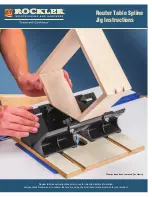
10
www.drilldoctor.com
www.drilldoctor.com
11
Identifying Basic Drill Bits
The Drill Doctor is most efficient when used to sharpen a drill
bit’s original point angle. With its standard Diamond Sharpening
Wheel it will sharpen high-speed steel, cobalt, TiN-coated, carbide
and masonry drill bits.
The Model 360X has been designed and engineered to sharpen the
most common drill point types:
Standard Point
This general-purpose point (normally
118°) is used for drilling softer mate-
rials like cold rolled steel, aluminum,
and wood.
Masonry Bits
Masonry bits have a carbide insert
at the point and are used for drilling
materials like cement, brick, and ce-
ramic.
It is important to understand that each
bit has a Chisel Edge, a Cutting Edge,
a Heel, a Relief Angle, and a Leading
Edge. (The Leading Edge will be im-
portant in bit alignment.)
When viewing a well-sharpened bit
from the end, the entire surface from
the Cutting Edge to the Heel will have
a finely ground surface without ridges
or indentations. The Heel will always
be lower than the Cutting Edge; this is
called positive relief.
Anatomy of a Drill Bit
Chisel Edge
Heel
Heel
Cutting Edge
Cutting
Edge
Relief
Angle
Leading
Edge
The Drill Doctor
®
Sharpening Process
The sharpening process includes 2 easy procedures:
1.
Aligning the bit in the Chuck.
2.
Sharpening the bit.
Aligning the Drill Bit
This makes sure that the Drill Doctor creates the right geometry.
It also sets the bit so that only a small amount of the tip is taken
off during sharpening.
(See page 14-15 to align and sharpen a masonry drill bit.)
Insert bit in Chuck.
Hold the Chuck with the White Tri-
angle facing up. Insert the bit into the
front of the Chuck, leaving 1/2” of bit
sticking out the front.
Tighten Chuck slightly.
Tighten the Chuck by turning the
Chuck Knob clockwise just to the point
where the bit is snug but can still be
slid in and out. The Chuck should not
be completely tightened until we set
the bit depth for sharpening in Step 4.
Align Leading Edge.
Rotate the drill bit in the Chuck so
that the Leading Edge of the flute is
against the Alignment Finger. This
aligns the bit for accurate sharpening.
Note:
A good test to see if the Chuck
is tightened the correct amount is to
make sure it moves when you pull on
it with your fingers, but will not fall
out when you turn the Chuck upside
down.
1.
2.
3.
1/2”
Leading Edge
Alignment
Finger
White
Triangle







































